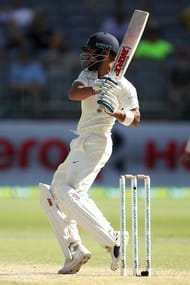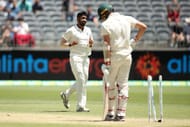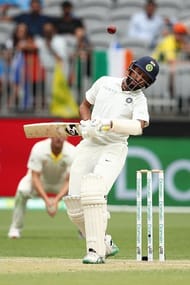
The first two Tests between India and Australia have been closely fought. Both in Adelaide and then in Perth, the Tests entered the fifth day with the result still uncertain, and each test has similarly seen a healthy balance between bat and ball.
The way India started encouraged many to think that this would indeed be the time that they earn their ever elusive Test series victory in Australia. In Adelaide, they fought in trying conditions against a strong bowling attack and kept their nerve to achieve a landmark victory.
However, the second Test felt like a regression. Despite the quality in their batting line up, they failed to match the runs scored by a much weaker Australian top seven. Furthermore, the selection of Umesh Yadav suggested a misreading of conditions and also left India with a particularly fragile tail.
The series is subsequently poised for a very entertaining final half. If Australia win just one of the next two Tests, then India will forego this golden opportunity to win a series in Australia. However, a win for India similarly means that they will retain the Border-Gavaskar Trophy.
Whichever side emerges from the series successful may depend on which side learns the most from the first two Tests.
India, for example, go to Melbourne with a handful of selection problems. Prithvi Shaw has unfortunately been ruled out of the tour, with Mayank Agarwal being called up as a replacement. Hardik Pandya also returns to the squad after recovering from injury to deliver an impressive performance in the Ranji Trophy. India's line-up for Boxing Day could, therefore, be quite different to the one they fielded in Perth.
In a peculiar reversal from the start of the series, Australia now have the more settled side. Their victory in Perth was their first Test win since the ball-tampering incident back in March. But as the following statistics reveal, they also have areas they must improve upon if they are to build on this victory.
#1 India have the top three run-scorers in the series

In the first two Tests, India were over-reliant on the runs of Cheteshwar Pujara, Virat Kohli and Ajinkya Rahane. Together, the three have scored 57.45% of the runs India have made in the series.
This is particularly worrying considering they are situated at three, four and five in the batting order. These three batsmen are all averaging above 40, with Pujara holding the best average at 55.50. They are also three of the four batters in the side to have played more than 50 Tests, with Murali Vijay being the other one. Their wickets, therefore, carry a great deal of weight to them.
The next best batsman for India this series is Rishabh Pant, who has scored between 25 and 36 in all four innings. He has looked streaky, but in Perth, he was put in an awkward position due to India's weak tail.
Pant is seventh on the list of leading run-scorers in this series, the next Indian batsman is Vijay, at fifteenth, with only 49 runs in the series.
The extreme disparity between India's best three batsmen and the rest of the side will no doubt lead to much debate about selections in the build-up to the third Test. It seems particularly unlikely that India will stick with the opening pair of Vijay and KL Rahul, but their lower order also needs to step up to give their side some depth.
However, these statistics also reveal much about the Australian side, as both the centuries scored in this series have been from Indian batsmen.
All of Australia's top seven have contributed in some capacity, but if India finds more depth with the bat, then Australia will need someone to stand up and make a big score. This will not be easy for them, as four of their top seven are still yet to make a century in Test cricket.
#2 Nathan Lyon has dominated the wickets charts

Nathan Lyon is comfortably the series leading wicket-taker thus far, with 16 wickets to his name already.
For a spinner in Australia, 16 wickets would often be a good return over the entirety of a four-match series, so that Lyon is already on this tally is very encouraging for Australia.
But it is also somewhat indicative of the conditions the Tests have been played in, as both pitches offered more for spin than Australian wickets conventionally do. In fact, despite not playing a specialist spinner in Perth, India have still taken eight wickets from spin in the series so far.
While India's choice to go with four pace-bowlers has been dissected in great detail, they should be encouraged by what they have seen in the pitches so far, as it means Ravichandran Ashwin may have a large influence on the next two Tests.
What the Melbourne pitch will provide is up for debate. It was rated 'poor' by the ICC after last years Ashes Test, as it offered precious little for bowlers. But Sydney, where the fourth Test will be played, is often the best venue for spin in Australia.
This could be good for India, as they have a fantastic spinner who is facing an inexperienced batting line-up with several players who are susceptible to spin. But it could also be a disadvantage if they continue to struggle against Lyon.
Now with 82 Tests and 334 wickets to his name, Lyon has improved and developed over the past few years to become a spinner who is effective in a range of conditions. The past couple of years have also marked the first time since Shane Warne where Australia have had a spinner whose selection is guaranteed for more than the next few Tests.
Lyon's growth as a player has strangely also improved Australia's batting, as his ability to hold down an end with the ball means that Australia have not needed to select an allrounder to ease the workload of the pace bowlers.
This is shown by the fact Lyon has bowled 123.5 overs in the series, whereas no other bowler has reached 100. How India plays him will be crucial in deciding the next two Tests.
#3 Jasprit Bumrah has bowled more maidens than anyone else

Despite having only played eight Tests, Jasprit Bumrah already looks like a seasoned veteran in Test cricket.
So far, Bumrah has had an excellent series, being the most economical of the pace-bowlers, and also having taken on the biggest workload. Bumrah has delivered 99.2 overs in the series, with 35 of them being maidens. He is currently also the equal second wicket-taker in the series, tied with Mohammed Shami on 11.
But Bumrah has comfortably been the most consistent of the Indian bowlers. He has taken three wickets in three of the four innings he has bowled in, and took two in the other one. Furthermore, his economy rate has never been above 2.40 in an innings.
This has meant that despite Nathan Lyon having the most wickets in the series, Bumrah's average is the best, at just 18.82.
Bumrah has managed to maintain impressive pace and accuracy throughout the series and has subsequently always been a safe pick for Virat Kohli to throw the ball to.
Kohli should also be credited for identifying Bumrah's effectiveness, and bowling him more than the other pace-bowlers, as the less experienced players often tend to bowl the least.
But Bumrah has also been able to bowl so much due to his fitness, and his economical run-up. If the Melbourne pitch does turn out to be as flat as it has been in previous years, then India may require Bumrah to shoulder an even heavier workload.
#4 No top seven batsmen averaging over 30 has had a strike-rate over 50

Australia used to be a country where runs were scored quickly. This was in part due to the attacking mentality Australia favoured, but also because of the quick pitches, where batsman were given full value for their shots.
However, drop-in pitches, like those in the first two Tests, and like the one in Melbourne, have meant that this has changed. No longer do Australian pitches have the pace they once did, and it is now seen that a more measured approach benefits batters the best.
Excluding Lyon, who averages 76 courtesy of three not outs, six batsmen currently average above 30 in the series: Pujara, Kohli, Rahane, Travis Head, Marcus Harris and Tim Paine. Of these six batters, Rahane has the highest strike-rate at 49.70, while Pujara has the lowest at 39.36.
It is perhaps telling that the three batsmen with a strike-rate of 50 or above, excluding tail-enders, are Rohit Sharma, KL Rahul and Pant. These three have struggled so far, although as previously mentioned, there are caveats for Pant.
But it has been notable that Rahul has constantly fallen to the drive when the players who have thrived have been much more judicious with their choice of the stroke.
Pujara, the leading run-scorer in the series, is the prime example of this. In his brilliant 123 in Adelaide, India lost their first four batsmen edging drives. Pujara saw this and almost entirely refused to play the shot for the bulk of his innings.
Pujara's success in Adelaide suggests not only that batsman may have to be more patient than they are used being in Australia, but also that reading the pitch quickly is paramount. This will certainly be the case in Melbourne, where the groundsmen are trying to create a very different pitch from last year.
#5 Australia's tail has contributed over four times as much as India's

While it is perhaps harsh to criticize a teams tail while their top seven has been imperfect, India's tail has been very poor.
So far this series, India's bottom four have made 51 runs in comparison to the 227 runs scored by Australia's bottom four.
What makes this especially alarming, is that 30 of those runs came from Ashwin in Adelaide. Their pace-bowlers currently average 2.10 with the bat in the series, with the highest score from them being Mohammed Shami's six in Adelaide, which he has since followed with three ducks.
Comparatively, all Australia's tail has contributed. Nathan Lyon leads the way, with his series of cameos with the batting seeing him with 76 runs in the series, having only been dismissed once. But Mitchell Starc, Pat Cummins, and even Josh Hazlewood, have all contributed.
This has been vital for Australia, as their top seven is fragile at best, and therefore needs all the depth its tail can offer. But it additionally also empowers their top seven when they find themselves batting with the tail.
The inverse of this was shown in India's second innings in Perth, where Pant refused to take singles when playing shot to fielders on the boundary, despite his side only being six wickets down.
India's tail will be improved massively by the return of Ashwin, but it is also important that their pace-bowlers step up, particularly as India have been so reliant on their top order.
Follow IPL Auction 2025 Live Updates, News & Biddings at Sportskeeda. Get the fastest updates on Mega-Auction and cricket news
